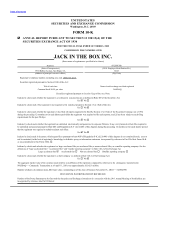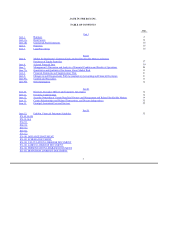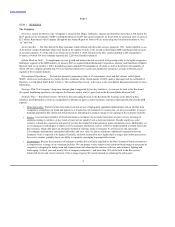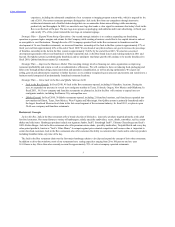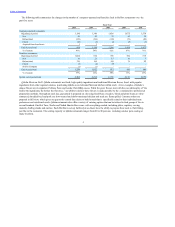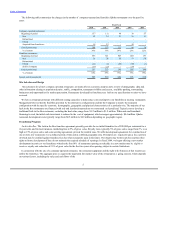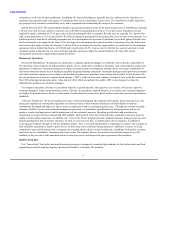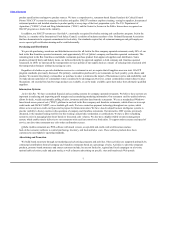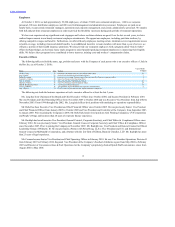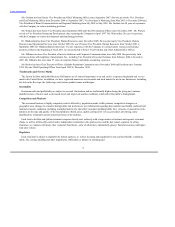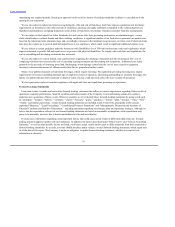Jack In The Box 2010 Annual Report Download - page 3
Download and view the complete annual report
Please find page 3 of the 2010 Jack In The Box annual report below. You can navigate through the pages in the report by either clicking on the pages listed below, or by using the keyword search tool below to find specific information within the annual report.
Table of Contents
PART I
ITEM 1. BUSINESS
Jack in the Box Inc. (the “Company”), based in San Diego, California, operates and franchises more than 2,700 Jack in the
Box® quick-service restaurants (“QSR”) and Qdoba Mexican Grill® fast-casual restaurants. In fiscal 2010, we generated total revenues of
$2.3 billion. References to the Company throughout this Annual Report on Form 10-K are made using the first person notations of “we,”
“us” and “our.”
— The first Jack in the Box restaurant, which offered only drive-thru service, opened in 1951. Jack in the Box is one
of the nation’s largest hamburger chains and, based on the number of units, is the second or third largest QSR hamburger chain in most
of our major markets. As of the end of our fiscal year on October 3, 2010, the Jack in the Box system included 2,206 restaurants in
18 states, of which 956 were company-operated and 1,250 were franchise-operated.
— To supplement our core growth and balance the risk associated with growing solely in the highly competitive
hamburger segment of the QSR industry, in January 2003 we acquired Qdoba Restaurant Corporation, operator and franchisor of Qdoba
Mexican Grill. As of October 3, 2010, the Qdoba system included 525 restaurants in 43 states, as well as the District of Columbia, of
which 188 were company-operated and 337 were franchise-operated. In recent years, Qdoba has emerged as a leader in the fast-casual
segment of the restaurant industry.
— We had also operated a proprietary chain of 61 convenience stores and fuel stations called Quick
Stuff®, which were each adjacent to a Jack in the Box restaurant. In the fourth quarter of 2009, under a plan approved by our Board of
Directors, we sold Quick Stuff. Refer to Note 2, , in the notes to the consolidated financial statements for more
information.
Our Company’s long-term strategic plan is supported by four key initiatives: (i) reinvent the Jack in the Box brand,
(ii) expand franchising operations, (iii) improve the business model, and (iv) grow Jack in the Box and Qdoba Mexican Grill.
We believe that reinventing the Jack in the Box brand by focusing on the following three
initiatives will differentiate us from our competition by offering our guests a better restaurant experience than typically found in the QSR
segment:
• . We believe that menu innovation and our use of high-quality ingredients differentiates Jack in the Box from
competitors, strengthens our brand and appeals to a broader base of consumers. In recent years, we have successfully leveraged
premium ingredients like sirloin and artisan breads in launching new products unique to our segment of the restaurant industry.
• . A second major initiative of brand reinvention is to improve the level and consistency of guest service. Investing in
employee training to reinforce six key tenets of guest service (quality food, a clean environment, friendly employees, order
accuracy, a hassle-free experience and speed of service) has resulted in improvement in guest-satisfaction scores. Additionally, we
are leveraging new technologies to improve service and guest satisfaction, such as self-serve kiosks installed at certain Jack in the
Box locations, which offer guests an alternative method of ordering inside a restaurant. As of fiscal year end, more than
230 company and franchise restaurants had kiosks, and over time, we plan to add them to additional restaurants where the
frequency of use is expected to be highest. Generally, our kiosk transactions have higher check averages than orders processed at
the service counters, partially due to our ability to customize messaging to prompt add-on items.
• . Because the restaurant environment is another driver of guest satisfaction, the third element of brand reinvention is
a comprehensive re-image of our restaurant facilities. We can portray a more cohesive and consistent brand image to our guests by
completely redesigning the dining room and common areas and enhancing the exteriors with new paint schemes, lighting and
landscaping. At fiscal year end, nearly 68% of company restaurants – and more than 55% of the Jack in the Box system –
featured all interior and exterior elements of the re-image program. We remain focused on enhancing the entire guest
2

